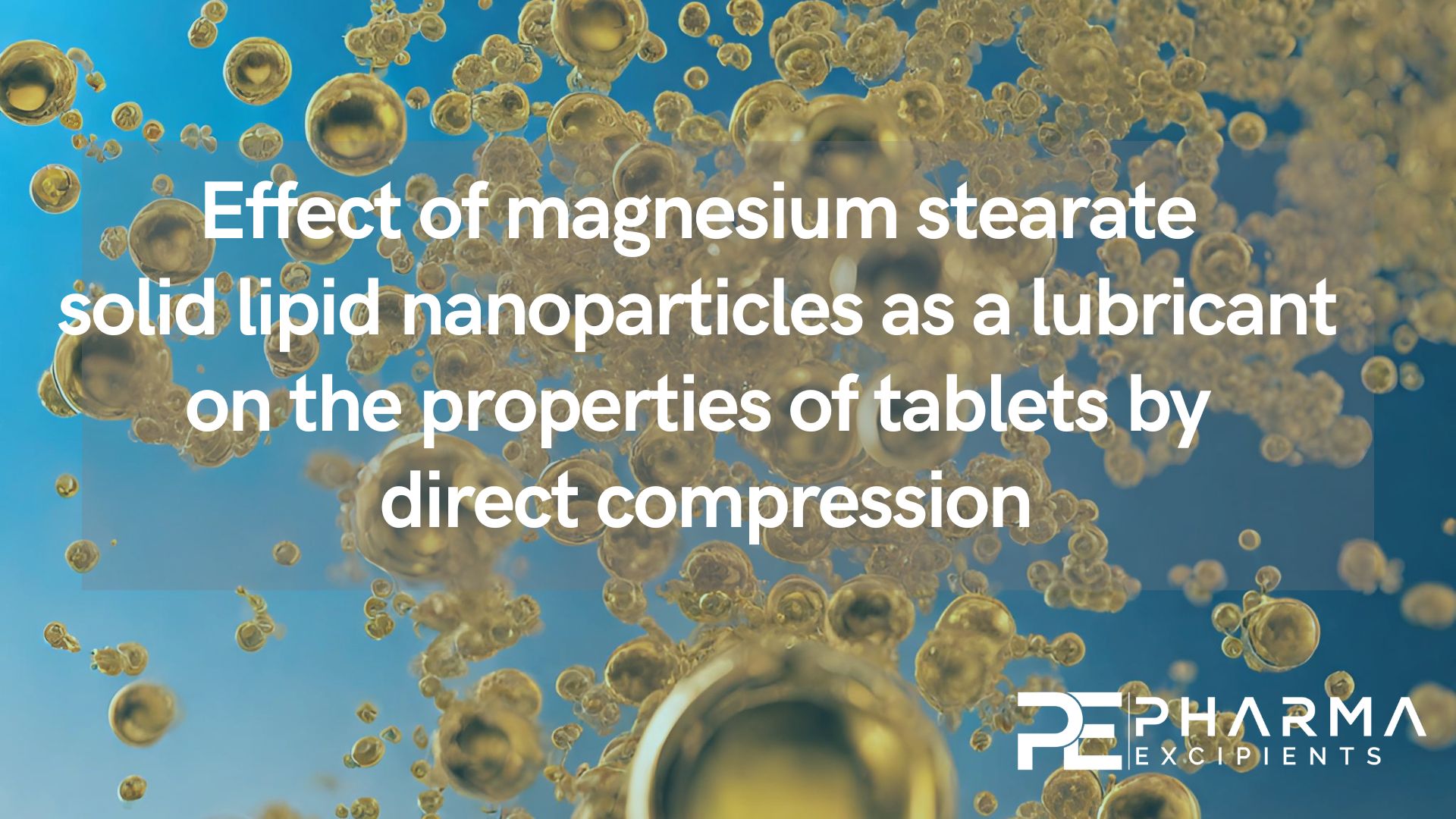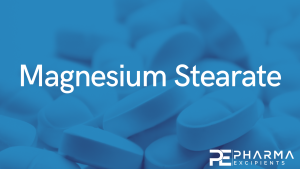Effect of magnesium stearate solid lipid nanoparticles as a lubricant on the properties of tablets by direct compression

Abstract
This study discusses the lubricant properties of magnesium stearate solid lipid nanoparticles (MgSt-SLN) and their effect on the tabletability, mechanical properties, disintegration, and acetaminophen-model dissolution time of microcrystalline cellulose (MCC) tablets prepared by direct compression. The behavior of MgSt-SLN was compared to reference material (RM) to identify advantages and drawbacks. The nanoprecipitation/ion exchange method was employed to prepare the MgSt-SLN. Particle size, zeta potential, specific surface area, morphology, and true density were measured to characterize the nanosystem. The MgSt-SLN particle sizes obtained were 240 ± 5 nm with a specific surface area of 12.2 m2/g. The MCC tablets with MgSt-SLN presented a reduction greater than 20% in their ejection force, good tabletability, higher tensile strength, lower disintegration delay, and marked differences in acetaminophen dissolution when compared to the RM. The reduced particle size of the magnesium stearate seems to offer a promising technological advantage as an efficient lubricant process that does not affect the properties of tablets.
Introduction
In recent years, pharmaceutical companies have demanded excipients that allow the development of better formulations using either new or improved materials that favor efficiency and reduce the cost of producing medicines [1]. In addition, the tendency to convert manufacturing processes of solid dosage forms into direct compression has increased the need for materials that improve these processes or make new ones feasible [2]. The excipients employed in the production of solid dosage forms include diluents/fillers, binders, disintegrants, glidants, and lubricants [3]. Though added to formulations in only small amounts, lubricants have a high impact on manufacturing processes and can significantly influence the bioavailability of active ingredients [4]. The functions of the lubricant are to ensure that the formation and ejection of the tablet proceed with low friction between the tablet and the die wall, and to prevent powders from sticking to the surfaces of the tablet punch [5]. An ideal lubricant should act by reducing shear strength at the interface between the tablet and die wall, and lowering the coefficient of friction and, hence, the frictional force at a given load. Lubricants must also be non-toxic, chemically inert, unaffected by process variables, and free of adverse effects on the finished dosage form [6].
Magnesium stearate is the lubricant most often used in the production of solid dosage forms due to its ability to efficiently reduce friction. It is also known to have strong negative effects on the binding properties of excipients [7], thus affecting disintegration and dissolution times, tensile strength, and incompatibilities with certain drugs [8], [9], [10], [11], [12]. Extended mixing times and adding higher concentrations of magnesium stearate (˃1%) can cause various problems both during and after tablet manufacturing [13]. Specifically, several studies have expressed a concern over delays in tablet disintegration times. Delays caused by magnesium stearate have also been shown to affect the bioavailability of active ingredients [14], [15]. Decreased hardness of tablets at higher levels of magnesium stearate [16] and extended mixing times [17] are other effects well-documented in the literature. For these reasons, it is necessary to achieve an efficient lubrication process that has less effect on the physical properties of tablets and the bioavailability of active ingredients.
Nanotechnology has been used to give excipients new and/or improved functions. One option for increasing the lubricant ability of magnesium stearate consists in reducing its particle size to the nanometric level. Friction reduction results from the physicochemical properties of this material, especially its specific area [18]. Therefore, as particle size decreases, a greater contact area becomes available, improving the tendency to form films. In a previous study, we reported the preparation of magnesium stearate solid lipid nanoparticles (MgSt-SLN) by the reaction of sodium stearate and magnesium sulfate using the nanoprecipitation/ion exchange method and their lubricant properties [19].
In an effort to expand the usefulness of MgSt-SLN, this study presents a new proposal to evaluate the tabletability, mechanical properties, and effect on the disintegration and dissolution times of microcrystalline cellulose tablets prepared by direct compression using MgSt-SLN as a lubricant excipient. The behavior observed was compared to that of conventional RM to determine the advantages and drawbacks of nanometer size.
Read more here
Materials and Methods
The sodium stearate and magnesium sulfate used to prepare the nanosystem were supplied by J.T. Baker. The stabilizing agent −polyvinyl alcohol (PVAL), molecular mass of 31,000 (Mowiol®488)− was provided by Hoechst (Frankfurt-am-Main, Germany). The ethanol used as the water-miscible solvent (analytical grade) was supplied by Fermont (Monterrey, Mexico), and the distilled water was of Milli-Q quality (Millipore, Bedford, MD, USA). The magnesium stearate raw material (RM) used as the reference lubricant was purchased from Mallinkrodt Inc. (St. Louis, MO, USA). The microcrystalline cellulose (MCC, Avicel® PH 200) used as a filler in the direct compression process, was supplied by FMC BioPolymer (Mexico City, Mexico). Finally, the acetaminophen used as the model drug was provided by Helm Mexico S.A. (Mexico City, Mexico). All reagents used were of the highest grade available from commercial sources.
Magnesium stearate solid lipid nanoparticles (MgSt-SLN) were prepared by the nanoprecipitation/ion exchange method based on the reaction of sodium stearate with magnesium sulfate using PVAL as the stabilizer, as described previously [19]. The nanoprecipitation process requires material solubilization in a water-miscible solvent, in this case, water:ethanol (70:30). This solution, which contained the sodium stearate (5% w/v), was added to the antisolvent phase (water) under mechanical stirring to control the size of the magnesium stearate particles that formed. The antisolvent phase composition was magnesium sulfate (1.5% w/v), which is required for ion exchange to occur with the sodium stearate and PVAL (1% w/v). After nanoprecipitation, the system was centrifuged at 20,000 rpm and 10°C for 30 min (Optima® LE-80K, Beckman Coulter, Inc., Fullerton, CA, USA), then washed twice with ultrapure water and resuspended in water. Finally, the MgSt-SLN were frozen and freeze-dried at a pressure <100 μbar and -50°C for 48 h (FreeZone 6, Labconco®, Kansas City, MO, USA).
Lizbeth Martínez-Acevedo, Moises Job Galindo-Pérez, Gustavo Vidal-Romero, Alicia del Real, María de la Luz Zambrano-Zaragoza, David Quintanar-Guerrero, Effect of magnesium stearate solid lipid nanoparticles as a lubricant on the properties of tablets by direct compression, European Journal of Pharmaceutics and Biopharmaceutics, 2023, ISSN 0939-6411, https://doi.org/10.1016/j.ejpb.2023.11.004.
Read more on Magnesium Stearate as a pharmaceutical excipient here:


